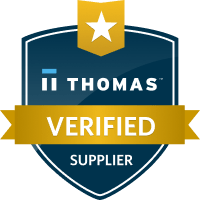CNC Milling Guide: Everything You Need to Know
Manufacturers use Computer Numerical Controlled (CNC) milling techniques to produce complex components in a fast and cost-effective manner. CNC machining controls rotating cutting tools via a computer programming interface. Following the program design, these tools systematically shape the source material into a customized finished product.
A number of common materials can be used in these processes, including:
- Aluminum
- Titanium
- Brass
- Wood
- Stone
- Copper
- Steel
- Stainless Steel
- Mechanical plastics (UHMW, Ultem, Acetal, Polycarbonate, Nylon, etc)
- Resins (fiberglass, carbon fiber, etc)
CNC milling facilitates the creation of highly accurate custom products from a variety of hard and soft production materials. The rotating tools, driven by their computerized instructions, progressively shave away, cut, and drill the material to create holes, slots, shapes, and other features required by the design.
There are four essential steps in CNC milling:
- Design. Using Computer Aided Design (CAD) modeling, engineers create visual representations of the desired end product.
- Conversion. CAD models are converted to Computer Aided Manufacturing (CAM) files, which instruct CNC machines on the necessary operations to realize the design.
- Set up. The machinery is set up to accept the programmed instructions and install the appropriate tooling so milling can begin.
- Operate. The CNC machine follows the program instructions, parts are inspected throughout production to ensure accurate finished products.
Throughout the process, engineers may adjust the programming to fit new parameters, implement improvements, or respond to unexpected situations.
CNC Milling Advantages
CNC milling offers a number of important benefits to manufacturers in different industries.
- Precision and uniform results. Five-axis CNC milling machines offer a high degree of accessibility and complexity, while minimizing fixturing requirements.
- High-volume production and scalability. After the initial set up, CNC milling machines can produce large numbers of components quickly. After programs have been optimized, the only way to scale machining production is through either additional milling centers, extending spindle hours per day via additional shifts, or through automation and lights-off tooling.
Labor costs are lower than manual milling, but this isn’t a good argument for CNC machining in this era. CNC Machining is one of the most expensive manufacturing methods and commands high hourly pay rates.With CNC milling, manufacturers make more products in less time with less risk of variation from the original design. There are plenty of new technologies that support variation mitigation, tool probes, dynamic offsets, in-tool diagnostics and vibration dampening, thermal indicators to reduce tool wear and heat warpage in parts, automated loading and unloading via robotics, and a long line of things.
CNC Milling Services
There are a number of choices for CNC milling operations. Each type has its own unique advantages and applications.
- Face milling employs a tool with teeth on both the periphery and face. This tool is used to make flat surfaces, smooth contours, and produce a higher quality finish than other shaping methods.
- Plain milling allows the shaping of large pieces of material. Wide cutting teeth allow the shaping of large areas of material while their narrower counterparts make deeper cuts.
- Angular milling adjusts the angle of cutters to produce chamfers, serrations, grooves, and other angular features.
- Form milling uses formed cutters to craft circular cavities, contours, and intricate patterns.
- Straddle milling is the process of cutting multiple pieces with one machine. Cutters are attached by an arbor and move simultaneously across adjacent surfaces.
- Gang milling uses multiple cutters on one machine arbor. These cutting tools are able to perform the same actions, creating complex parts in less time.
- Profile milling refers to the process of cutting vertical or angled pathways across the workpiece.
- This section seems to only have words that would come up if you googled “types of milling” but doesn’t seem to align with “choices for CNC milling operations” that is in the header. Drill, bore, ream, step/ramp mill, thread mill, tap, 3D contouring, swarf, high speed machining (constant engagement), are just some of the common operations.
There are also different types of CNC milling machines. Which machine is appropriate depends on the complexity and details of the design.
- A vertical mill orients the spindle axis vertically. This allows easier cutting and drilling of some materials.
- Horizontal mills operate on a flat, level plane. These devices are better for shaving and cutting.
- A turret mill features a stationary spindle on a table that can move in both perpendicular and parallel directions. These machines are highly versatile for their compact size.
- Bed mills are similar to turret mills. However, the tables on these machines only move in a perpendicular direction.
There are a number of components that make up CNC milling machines:
- Machine interface
- Column
- Knee
- Saddle
- Worktable
- Spindle
- Arbor
- Ram
- Machine tool
Each of these components is a vital part of producing parts. CNC milling is an integral process in the manufacture of a wide range of products—far too many to list here. Examples include:
- Car Engines
- Industrial equipment
- Aerospace components
- Furniture
- Cabinets
- Musical instruments
- Electronics
- Cell phones
- Construction/Infrastructure
- Consumer products
- Die making for injection molding/casting
CNC milling is a flexible method for producing highly customized components quickly, accurately, that avoids high initial tooling costs for production. Find out what CNC machining services from Pro-Type Industries can help your company save time, money, and frustration in your production processes.

